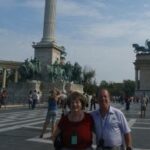We’ve finally got connectivity–and I’m in the middle of the Danube River docked at Bratislava. Great trip about to end, marked by the “c’s–churches, cathedrals, canals (and rivers) and castles. More to come when I get home–we’re off to Budapest, where we leave the ship for home.
Reminiscences of 2024


Once on the boundary between civilized Rome and the Germanic Barbarians, what is now Bratislava was once a ping pong ball between Austria and Hungary. When the Turks took Budapest, after the battle of Mohacs, then Pozsony/Pressburg became the capital of Royal

Hungary. Even after the capital returned to Budapest, the kings and queens of Hungary were coronated in Pozsony, and the Hungarian Diet met there into the 19th century. When Czechoslovakia split, Bratislava became the capital of Slovakia.
Hungary were coronated in Pozsony, and the Hungarian Diet met there into the 19th century. When Czechoslovakia split, Bratislava became the capital of Slovakia.

Budapest is the name for what used to be cities on both sides of the Danube, a city outsized for the country it now dominates. A third of the Hungarian population lives in the city. Settled originally by Celts, and later Romans, Magyars under Arpad arrived on the Hungarian plains in 896, bringing a non-Roman language to Europe (Magyar). Heroes Square commemorated the centennial with statues.

 By 1000 King Stephan had converted to Christianity and created the Kingdom of Hungary, which lasted more or less until the end of World War II. Tradition says St. Stephan built the Matthias church, which has been rebuilt several times (it was a mosque under the Turks). The independence was lost to the Turks, who ruled Budapest for 150 years, after which Hungary became part of the Austria Empire. Restive for many years, eventually Hungary became part of the Dual Monarchy in 1867, with
By 1000 King Stephan had converted to Christianity and created the Kingdom of Hungary, which lasted more or less until the end of World War II. Tradition says St. Stephan built the Matthias church, which has been rebuilt several times (it was a mosque under the Turks). The independence was lost to the Turks, who ruled Budapest for 150 years, after which Hungary became part of the Austria Empire. Restive for many years, eventually Hungary became part of the Dual Monarchy in 1867, with
 its own parliament and army; the duality led to over a month of dickering in 1914 about whether to declare war on Serbia (Austria) or Romania (Hungary).
its own parliament and army; the duality led to over a month of dickering in 1914 about whether to declare war on Serbia (Austria) or Romania (Hungary).
The boat docked here and we had excursions from a hotel in the city. Hungary changed sides in World War II, which led to a brutal German defense that pretty much destroyed Buda castle. Reconstruction, however, revealed a number of other sites underneath, leading to 6 museums on the hill. I visited all 6, which was easy since most of the explanations were in Magyar.
War II, which led to a brutal German defense that pretty much destroyed Buda castle. Reconstruction, however, revealed a number of other sites underneath, leading to 6 museums on the hill. I visited all 6, which was easy since most of the explanations were in Magyar.
 The Parliament building, once the largest in the world, still has bullet holes from the abortive 1956 efforts of Hungary to break free of the Communist
The Parliament building, once the largest in the world, still has bullet holes from the abortive 1956 efforts of Hungary to break free of the Communist yoke.
yoke.
Final dinner left us hungry for more trips to Hungary and other countries. I’ll drink to that!